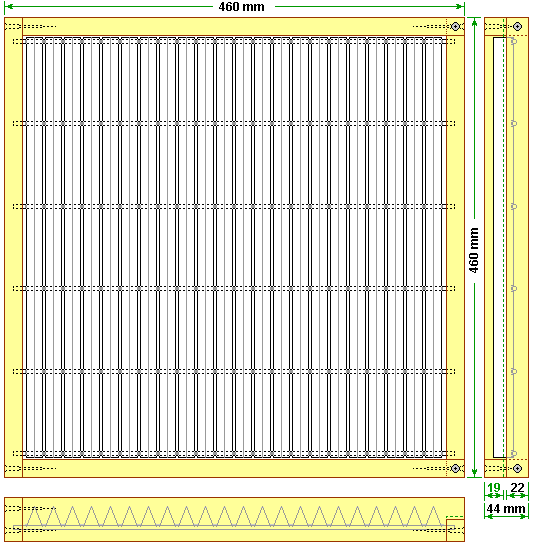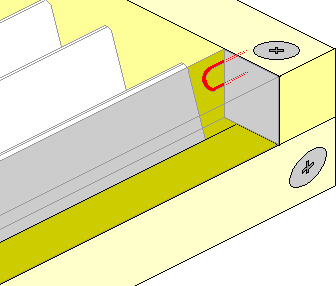Metalwork
18 mm Woodwork
19 mm Woodwork
|
|
|---|
|
Metalwork 18 mm Woodwork 19 mm Woodwork |
The Cushman Floor
|
|---|
|
I have to apologise for appending my name to this device, but I could not think of a cryptic or descriptive title for it. It is an attempt to retain the varroa shedding qualities of the "Open Mesh Floor", but at the same time reduce the excessive ventilation that causes some strains of bees to treat the lower 100 mm or so of their comb, in a different fashion to what they would if the ventilation was not present. |

|
|---|
I feel that, by this approach we can imitate more closely, the conditions that prevail in a "hollow tree" natural nest and hopefully deter the sort of wax moth attack that is so often associated with the sliding panels that are used for mite monitoring and to reduce ventilation.
The details of the dimensions are due to the existence of a jig for the manufacture of queen excluder grids. This jig is one of the manufacturing aids of B.J. Engineering who are manufacturers of metal components for beekeepers and the beekeeping appliance trade. (You should consult them if you wish to purchase the metal floor insert.)
The view shown right is with the frame made from 18 mm thick timber, if 19 mm is used the gap between the frame and the grid is reduced by 1 mm all round. It is important that the gap is never more than 3.5 mm otherwise there may be trouble with robber bees or wasps.
The dotted green line represents the edge of
the entrance if an 18 mm Whichever size of entrance block is used, a pair of staples should be fitted into the side walls so that the block cannot fall inside the floor. This is illustrated for a 21 mm square entrance block, below left. |

|
|---|
|
If an 18 mm entrance block is used it will align with the frame material. The illustration depicts the entrance block as a grey "ghost". The 18 or 19 mm frame width was chosen owing to the use in Britain of "cold way" and "warm way". The design will shed just the same amount of varroa whichever method is in use. Assembly is by gluing and screwing, using six, #6 x 50 mm twin thread screws and two #6 x 30 mm screws. The two smaller screws that are used vertically should have their tips filed, or ground, down so that they do not interfere with the longitudinal screws. |

|
|---|
The ventilation is much less (about 85% less) than a comparative area of "8" mesh.
The principle is simple... varroa mites will fall either by accident or due to chemical narcosis. The radius of the fold at the top of each strip is small and the sides are particularly steep. Any falling mite is doomed to fall through one or other of the gaps. The only place where they may possibly ledge is the small welded tabs on the tie bars and that represents less than one percent of the area of the floor.
Operation is completely passive and the floor can be left in position at all times during the year. No provision is made for monitoring mite drop, but it envisaged that the user will place a sticky board, with a mesh screen covering, directly on the ground between the legs of the stand, when counting is required.
This floor should not be considered a "treatment" for varroa, however it should be used as a part of "Integrated pest management".
This metal version may be sterilised by wiping a gas flame over it, but could be subject to corrosion if organic acids are used as part of your management. If the item proves popular enough a redesign would be possible using an injection moulded plastic grid that would withstand such acids.
Cost is a big issue with most beekeepers, but this version will compare favourably with an open mesh floor made from galvanised "8" mesh, which is a relatively expensive item. It should prove durable if the wooden parts are coated with linseed oil, the metal grid should not be oiled as that cause a sticky 'varnish like' coating might arrest a falling mite.
Various estimates have been made in the past about the number of mites that will lose their grip and fall from the bees. I am not concerned what the actual figures are, all I am prepared to say is that around 99% of mites that would have fallen on to a conventional floor, will meet their doom by this method.
Many beekeepers express concern that an open mesh floor will be too draughty for the bees. I personally think that the bees cope admirably, but some colonies do re-arrange their nests in the lower portion of the frames if they are used. This floor has considerably reduced ventilation compared to mesh and should satisfy those beekeepers that are concerned, and should cause less alteration to the way the bees that are sensitive to excessive ventilation use their comb.
This document links back to "British Standard Beehive and Frame types" and thence to both the "National" menu and the "Rational" menu as the device is equally valid for both top bee space and bottom bee space use.
Since the initial writing of this page a couple of designs have been published that use rigid plastic tubing to create a similar sort of floor grid with gaps for varroa to fall through. The use of plastic enables the use of organic acids in varroa treatment, but the plastic tubing has to be of very high quality to achieve the degree of stiffness that is required to maintain the gaps 'bee proof'. The tubes are large and their diameter is slightly smaller than the inter comb spacing in most hives. So if they are spaced on the same pitch as the frames each gap will be in exact register with the seam between the frames. A type of floor that uses this feature is described on this French site.
Originally written by Dave Cushman.
Page created 01/06/2001
Page updated 21/08/2022
Printed from Dave Cushman's website Live CD version
Written... 01 June 2001, Revised... 04 February 2002, Upgraded... 22 October 2004, Further Upgraded... 06 December 2007,
|